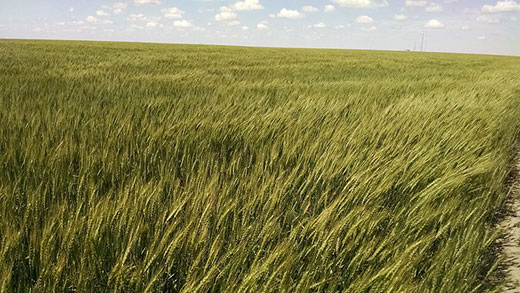
Researchers at Kansas State University have studied the performance of 28 wheat varieties in a dual-purpose system. (File photo)
K-State researchers study wheat for grazing, grain
Year-long study helps identify varieties ideal for dual-purpose system
August 21, 2020
MANHATTAN, Kan. – Kansas State University researchers have released findings of a study to identify the best-performing varieties when producers are growing wheat for grain and grazing, known as a dual-purpose system.
K-State Research and Extension wheat specialist Romulo Lollato said he and his colleagues tested 28 wheat varieties at the South Central Experiment Field near Hutchinson – simulating grazing the crop in the winter and early spring and harvesting grain in the summer – to determine how the performance of different wheat varieties compared when managed under the dual-purpose system versus a grain-only system.
Their results are now available in a publication available from the K-State Research and Extension bookstore.
“The three most important things that we need to keep in mind when selecting a wheat variety for a dual purpose system are fall forage production, the date of the first hollow stem and how varieties respond to grazing stress,” Lollato said.
The yield potential of fall forage is important because it affects the potential beef production from cattle grazing wheat in the fall, winter and spring. Lollato said approximately 100 pounds of beef can be produced for every 1,000 pounds of dry matter, wheat forage production in an acre.
The date of the first hollow stem will determine when producers should stop grazing cattle. Grazing past the first hollow stem can decrease the following spring’s wheat yield by as much as 1% to 5% per day, Lollato said.
How well wheat varieties respond to stress often shows up in its’ grain yield following grazing, as compared to the ungrazed counterparts.
“The recovery of wheat varieties from grazing is very specific to the variety,” Lollato said.
He said that one trend researchers found in their study is that wheat yields in a grain-only system might not necessarily indicate how a variety would stack up in a dual-purpose system.
“What we saw this year is typically what we see year in and year out,” Lollato said. “Sometimes in the dual purpose situation, we have different varieties showing up toward the top (of the wheat yield rankings). The potential to bounce back from grazing is showing up whenever we look at the ranking of those varieties in the dual purpose situation.”
For example, Lollato said a few varieties were among the top yielding group in both grazed and ungrazed scenarios, including Rock Star (a Polansky variety) and two Westbred varieties, WB4269 and WB4699.
“When evaluating the grazed plus grain group only, other varieties, including a few from Oklahoma State University, also appeared in the top yielding group, showing that those varieties might be better suited for the dual-purpose system,” he said.
The researchers tested several varieties grown in Kansas and the surrounding region, including varieties from Oklahoma. The new publication outlines those varieties that are expected to be the best candidates for a dual-purpose system, based on being exposed to grazing stress during the early stages of development.
Lollato also has posted the publication and other updates regarding Kansas wheat production on Twitter; search for @KSUWheat.
